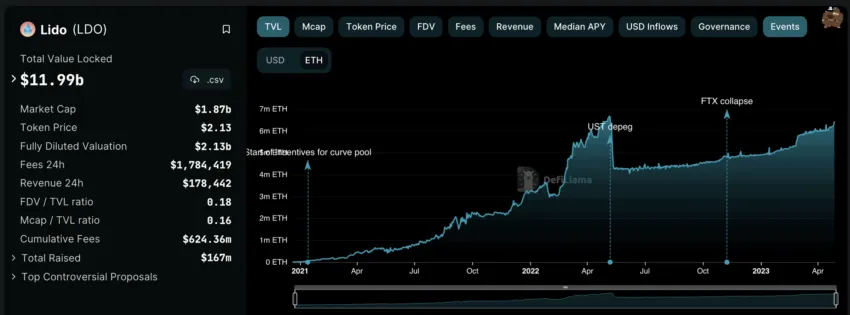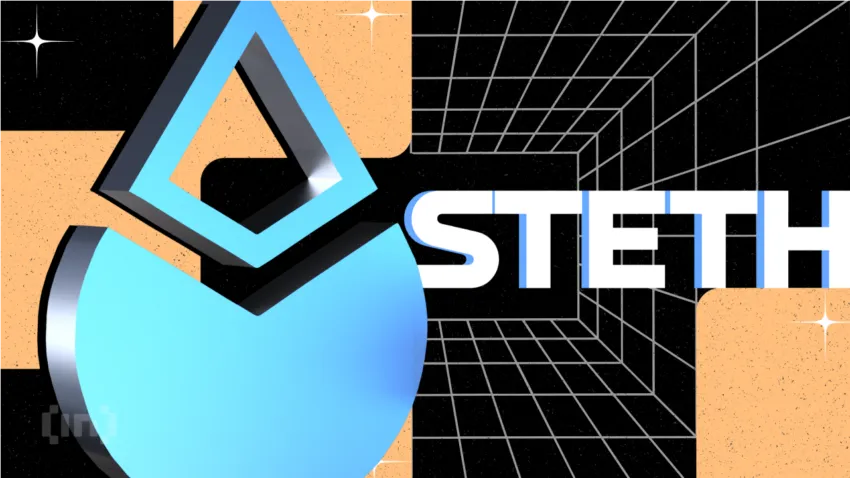From staking rewards and pools to the role of Ethereum derivatives like stETH and rETH in the DeFi ecosystem, there’s a lot to know about staking ETH. Here we explain one aspect — Lido staking — unpacking everything you need to know about Lido Finance and its popular stETH token.
BeInCrypto Trading Community in Telegram: read reviews on the best crypto projects, read technical analysis on coins & get answers to all your questions from PRO traders & experts!
- Ethereum staking: why is it sought after?
- What is the Lido staking platform?
- Unpacking Lido’s staked ETH (stETH)
- stETH as a liquid staking solution
- Risks and considerations involving staked ETH
- The state of Ethereum staking post-Shanghai: Lido in focus
- What are the stETH use cases?
- How to stake with Lido: steps and more?
- Staked ETH on Lido: the platform of choice?
- Frequently asked questions
Ethereum staking: why is it sought after?

Before we dive into the world of liquid staking with Lido, here’s a quick refresher regarding Ethereum’s staking utility.
Like any other proof-of-stake blockchain, staking is important to keep the Ethereum network secure. Validators — who give the go-ahead to transactions — stake their share of crypto (ETH in this case) to establish credibility. And guess what? They receive staking rewards — incentives for keeping the network secure and working. Network security. Validators. Staking rewards. It all seems pretty straightforward, right? Well, not quite.
With the Ethereum Merge, the network became a significantly more energy-efficient ecosystem. Yet, before the recently concluded Shapella (Shanghai) Upgrade, staked Ethereum was locked Ethereum — all thanks to the ETH 2.0 contracts.
Liquid staking providers like Lido Finance and their derivatives like staked ETH made life easier for stakers, helping them experience the benefits of staking without a lock-in period. Yet the recent unlocking of ETH 2.0 contracts further intensified the ETH staking game.
Staking on Ethereum is attractive for a number of reasons. For one, users need not worry about exchange volatility as income is generated purely based on the efforts of the validator. Vitalik Buterin highlighted this back in 2020.
If you’re staking, there is no “exchange rate” risk; your coins are just locked up until the transition happens, and after the transition they’re 1:1.
Vitalik Buterin, Ethereum co-founder: Twitter
Unpicking the 32 ETH limit that birthed liquid staking solutions
Even though Ethereum staking is and was a profitable way to generate passive income, the requirement of a minimum threshold of 32 ETH for direct staking was an impediment to many. Note that before the Shanghai upgrade, every bit of those 32 ETH, if used, had to be locked in an ETH 2.0 staking contract. And so many individual retail stakers shifted to liquid staking platforms like Lido Finance.
The likes of Lido allowed users to stake any amount of ETH, helping redirect the stakes to specific validators via smart contracts.
The ETH staked by individual users using Lido staking was still locked. But Lido allowed users to reap the benefits of their locked stake using stETH — an unlocked derivative.
Summing up the staking scene
- Ethereum staking is necessary to keep the network secure.
- Validators keep the network secure by validating transactions, but to qualify, they need 32 ETH staked.
- The 32 ETH staked Ethereum threshold meant that individual stakers were taken out of play.
- Lido, one of the few popular liquid staking platforms, allows individuals to stake even the smallest bits of ETH holdings via stETH — a derivative token.
- Lido uses a set of smart contracts to subtly delegate the staked Ethereum to specific validators, all while giving out the equivalent 1:1 amount of stETH to the stakers.
Here is a Dune dashboard illustrating the lead that liquid staking platforms have over other forms of staking.

It’s of little surprise that liquid staking solutions like Lido are so popular. But what does Lido offer, and why is it the platform of choice for many Ethereum stakers?
What is the Lido staking platform?
In sum, Lido is an Ethereum-based staking solution with the aim of simplifying Ethereum staking. Lido makes Ethereum staking and the staking rewards more accessible to standard users — who do not have 32 ETH to lock. Users can stake their ETH with Lido, getting stETH tokens in return.
You can consider stETH as the usable receipt for staking Ethereum with Lido.

Here are the quick Lido traits to help you understand the offerings better:
- Lido is a DAO — a decentralized autonomous organization — with LDO acting as the governance token. Holding LDO allows users to vote on ecosystem-specific activities, upgrades, and changes.
- Lido takes smart contract security seriously by resorting to extensive audits and proactive arrangements. It even has Slashing insurance in place — whereby individual stakers do not end up losing a part of their stake due to a validator oversight.
- Lido’s stETH derivative tokens are pegged to the price of ETH in a 1:1 ratio. And the staked ETH tokens aren’t just receipts. Stakers can use stETH extensively across the DeFi ecosystem via stETH liquidity pools, staking pools, diverse custody options, and more.
Lido’s DeFi presence
We cannot discuss Lido without considering its DeFi presence. Looking at the protocol spread for a total DeFi ecosystem TVL worth $66.20 million, Lido currently holds the top rank with a TVL worth $12.03 billion as of May 1, 2023. Do note that this excludes the liquid staking inflows and paints a generic picture of Lido Finance — the decentralized finance protocol.

Lido currently has a DeFi dominance of over 18%. The protocol has seen an 11.78% rise in its month-on-month TVL, signifying growth. With the wider DeFi outlook covered, let us now shift attention to Lido’s quantifiable traits.

ETH staking on Lido: what to expect?
Before we get up close and personal with stETH on Lido, here is everything that you need to know:
- Staked ETH on Lido can generate an APR (Annual Percentage Rate) of 4.8%.
- The yield, in this case, is paid in stETH and doesn’t take compounding into the equation. Hence, it’s APR and not APY.
- Pool validators can earn up to 15% APR.
- As of April 28, 2023, 100% of stETH tokens are in circulation, taking the circulating supply to over 6 million.

Note: Per data from Staking Rewards, the adjusted staking rewards might come in at 5.19%. This is higher than the declared APR of 4.8%, as it might take time for the validator transactions to go through.

Why stake ETH on Lido?
If the ability to use stETH across platforms to generate additional yields isn’t reason enough to choose Lido, let us offer a few more:
- Focus on risk diversification: Your staked ETH moves across multiple node operators via smart contracts to lower the staking and slashing risks.
- MEV-powered staking rewards: This method is all about outsourcing block construction to third-party builders, with the sole aim of earning higher rewards by distributing MEV rewards. And when validators earn more, the same is passed on to stETH holders via value accruing.
Lido DAO, along with a sub-governance group targeting professional node operators, picks the most high-value and secure node operators to stake ETH.
Therefore, the APR may continue to change depending on the market conditions, the success rate of validators, the nature of node operators, and other factors.

Unpacking Lido’s staked ETH (stETH)
stETH (or Lido Staked Ether) is how ETH tokenization happens at Lido Finance. Users who stake their ETH using Lido staking get stETH tokens in return. These tokens represent the staked ETH of the user, working as a receipt in the process.
stETH itself is an ERC-20 token with its value pegged to the value of ETH in a 1:1 ratio. But is the value always the same?

The curious case of stETH depegging
Ideally, one stETH should always be equal to one ETH. Yet, as it is a representation of ETH, it is common for the value to drop momentarily in case of market uncertainty — something that happened during the Terra crash.
Here is how the stETH-ETH price fluctuations have been over the past several months.

Should market conditions turn volatile and people start losing trust in pegged assets, the likes of stETH may deviate from the ETH peg. This may be because users want to sell their receipts for the best price they can get during testing times.
How is stETH created?
To create or rather get stETH, you first need to stake your ETH via Lido staking. We will cover that process in more detail later.
Once a user stakes ETH, Lido’s node operators move the coins to the Beacon Chain of Ethereum 2.0. On the chain are validators who stake the same ETH on behalf of the users. The validators, in turn, earn staking rewards, which are distributed among the ETH stakers per the ratio of their holdings.
How are staking rewards distributed?
When it comes to Lido staking, your stETH isn’t just a representation of the staked ETH. Instead, your stETH bag grows over time. Staked ETH tokens employ a type of “value accruing mechanism” to calculate and distribute rewards.
As the ETH 2.0 chain generates staking rewards for the validators, the value of each stETH token keeps growing. This increase in value is eventually distributed among the stakers in the ratio of their holdings.
Let us assume that there is a $10 pizza, equally distributed amount ten people as ten slices. Each slice would now be priced at $1. Now imagine that it suddenly becomes the last pizza ever, pushing the total price to $100. This way, the value of each slice also grows in the same ratio as the entire pizza — becoming $10 instead of $1.

In relation to stETH, value accruing works when the value of each stETH token (like the pizza slice) increases as the rewards accrue. Per this mechanism, there is no change in the number of stETH you hold. Just the value of each stETH increases and reflects in your Lido account. As the value of stETH keeps growing, you can term these as rebasable tokens — as the value automatically rebases itself per the rewards.
stETH as a liquid staking solution
Here are some of the more interesting things that you can do with your stETH, apart from earning passive income as staking rewards:
- As Lido staking is a form of liquid staking, there are a number of ways you can utilize your stETH. This includes interacting with the DeFi ecosystem and using stETH tokens to provide liquidity to stETH liquidity pools. This is especially useful for those who want seamless and quick ETH to stETH conversion.
- You can even participate in other decentralized finance activities like yield farming, lending, borrowing, and more on DEXs.
- stETH allows you to rehypothecate the ETH holdings and trade the staked positions by using the same as collateral. For the unversed, rehypothecation means using pledged assets (ETH in this case) as collateral in other cases. The receipt of the first pledge (ETH to stETH conversion) is used as collateral for getting a DeFi loan or for any other form of activity.
Note: Some DeFi ecosystems like UniSwap and SushiSwap do not directly support rebasable tokens like stETH. In that case, you might have to wrap these tokens to use them and receive the re-staking rewards as well (not the standard ETH staking ones). That version of stETH is termed wstETH or wrapped staked ETH.
Risks and considerations involving staked ETH
Even though liquid staking your ETH using Lido is relatively safe, here are some of the potential risks that you should be aware of before proceeding:
Smart contract pitfalls
Lido is powered by smart contract security, where the ETH you stake moves to the node operators in a trustless manner. And even though Lido relies on extensive smart contract security tests and audits before proceeding, anything with code comes with its share of risks. A smart contract bug can make your assets vulnerable to hacks.
Slashing risks
With the ETH 2.0 upgrade, the Ethereum Network has now moved to the proof-of-stake mechanism. And while validators can stake their holdings to establish credence and validate transactions, there are some penalties involved for the rogue validators — the slashing penalty. As staking providers like Lido move individual ETH to the node operators, any instance of validator penalty might even slash the amount of staked ETH.
Lido tries to mitigate some part of this slashing risk by having slashing insurance in place. Even though the insurance provides partial coverage, it might not be able to cover sizable slashing losses. Simply put, you might not be in control of your ETH and might be at the mercy of the validator’s judgment or the lack thereof.
Market and even liquidity risks
As mentioned previously, you might consider using your stETH to generate income via other decentralized finance activities. But that comes with market risks. Imagine stETH depegging from ETH — as it happened during the Terra crash, in which the algorithmic, so-called stablecoin promptly imploded. In that case, your rehypothecated loans and collaterals might suddenly be liquidated, incurring losses in the process.
And even though stETH is supposed to be more liquid than other staking derivative tokens, some stETH liquidity pools might not be as liquid, depending on what trading pairs are in play.
Regulatory risks
LDO — the native governance token of Lido — dipped close to 10% on rumors of being served a Wells notice from the SEC. Even though that was just a rumor, regulatory risks remain while dealing with stETH tokens.
The state of Ethereum staking post-Shanghai: Lido in focus
Before we discuss the current state of staked Ethereum, here is a quick snapshot for your reference:

It is evident how significant the share of liquid staking is, especially post the Shanghai upgrade. Do note that the centralized exchanges come after the liquid staking platforms with at least a 10% lesser share. This shows that people are willing to move their staked Ethereum to a liquid staking platform. And Lido seems to be the most obvious choice, with a 30.24% of liquid staking market share.

And that is exactly why Lido deserves a separate discussion.
Also, Lido has a 73.92% market share when it comes to the TVL of all the LSD (liquid staking derivative) ETH.

And this stat comes at a time when on April 20, 2023, a staked Ether outflow worth $1.3 billion was recorded, primarily from the CEXs. As of April 28, 2023, only 3.38% of staked Ethereum appears ready for withdrawals, per Nansen. This might be a sign that people are planning to play the waiting game and focus more on passive income rather than cashing out their ETH.

Below is a graph that shows that the locked ETH volume did drop following the Shapella upgrade but has moved to all-time highs.

Another interesting observation concerning Lido is that it takes a 15.6% share with it comes to all-time ETH withdrawals post-Shanghai. And none of the ETH withdrawn is the principal or the initial deposit, meaning users have only been looking at withdrawing staking rewards for now.

Here is another Dune dashboard that mentions that a major chunk of ETH deposited to Lido belongs to the Kraken cohort:
And that sums up the popularity of Lido as the leading LSD platform.
What are the stETH use cases?
We have mentioned how flexible stETH was in regard to generating additional passive income. Here are some of the specifics:
- You can use stETH for lending and borrowing via platforms like Cream Finance and Aave without having to unstake the ETH in the first place.
- A good way to leverage stETH is by providing liquidity to specific stETH liquidity pools on DEXs like Curve, Uniswap, and more. This way, it is possible to earn trading fees and even incentives for liquidity mining.
- Farming pools like Concentrator can help you generate APYs amounting to 5.90%.
- You can use the Yearn Finance yield aggregator, Curve Finance’s stETH-WETH liquidity pool, and Curve LP tokens to make deposits that can generate up to 3.64 APY.
- Using stETH on Idle Finance — a yield automation protocol — can help you generate yields between 8.57% APY and 1.32% APY, depending on your risk appetite.
And these are just a few options to maximize your earning potential using stETH.
How to stake with Lido: steps and more?
The only thing that remains between those stETH yields and your ETH reserves is a quick “how to stake with Lido” explainer. Well, it’s as simple as it gets.
You need to head over to the “Stake Ether” interface, connect the wallet where you might be parking your ETH, read and accept the terms, and click confirm.

Do note that you should have some additional amount in your wallet to pay gas fees. Once staked, an equivalent amount of stETH shows up in your compatible wallet. You will notice that the ETH staking rewards are updated daily in your wallet.
Staked ETH on Lido: the platform of choice?
Lido-staked ETH stands for accessibility, period. And while there are other liquid staking solutions on the market, including Rocket Pool with a 6.73% market share and Coinbase wstETH with a market share of 13.81% — Lido staking leads the pack in terms of credibility and ease of usage. Lido also has an official scorecard for ETH staking, further demonstrating the platform’s commitment to making the liquid staking stETH space better and more transparent for its users.
Remember that while Lido initiates extensive and periodic audits, there’s no guarantee that your crypto will be 100% safe at all times. Slashing risks, regulatory risks, market risks, smart contract risks, and liquidity risks all exist in this dynamic space.
Frequently asked questions
What is staked Eehereum?
What is the difference between ETH and stETH?
How to convert ETH to stETH?
Where to buy stETH?
What are the benefits of staking?
How much stETH can you earn from staking?
Is stETH safe?
What are the stETH liquidity pools?
Can you unstake stETH?
Disclaimer
In line with the Trust Project guidelines, the educational content on this website is offered in good faith and for general information purposes only. BeInCrypto prioritizes providing high-quality information, taking the time to research and create informative content for readers. While partners may reward the company with commissions for placements in articles, these commissions do not influence the unbiased, honest, and helpful content creation process. Any action taken by the reader based on this information is strictly at their own risk. Please note that our Terms and Conditions, Privacy Policy, and Disclaimers have been updated.




